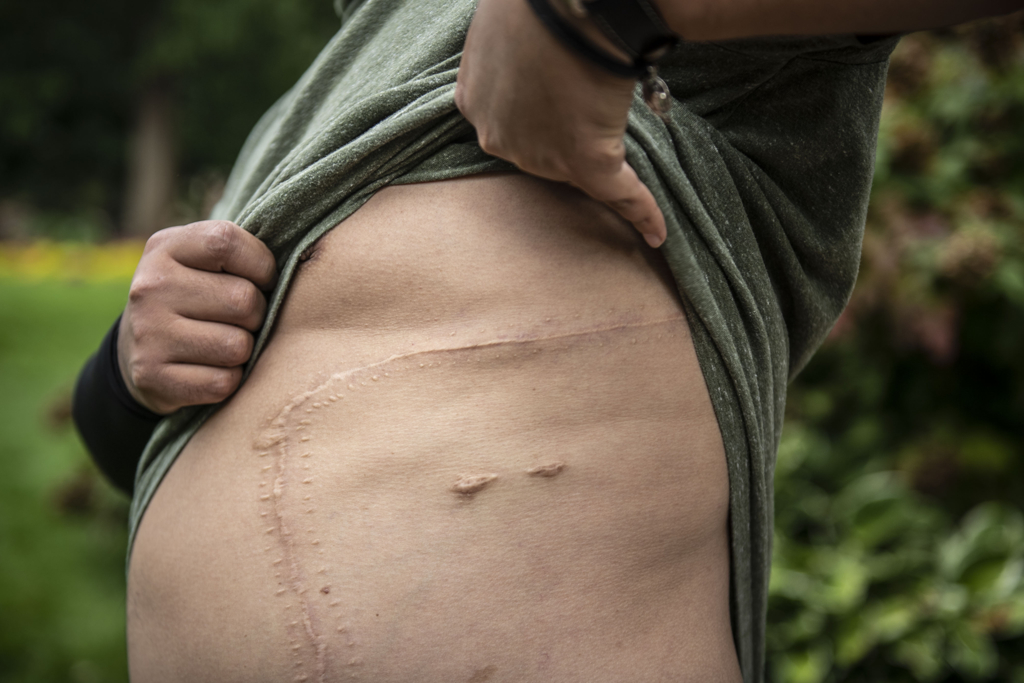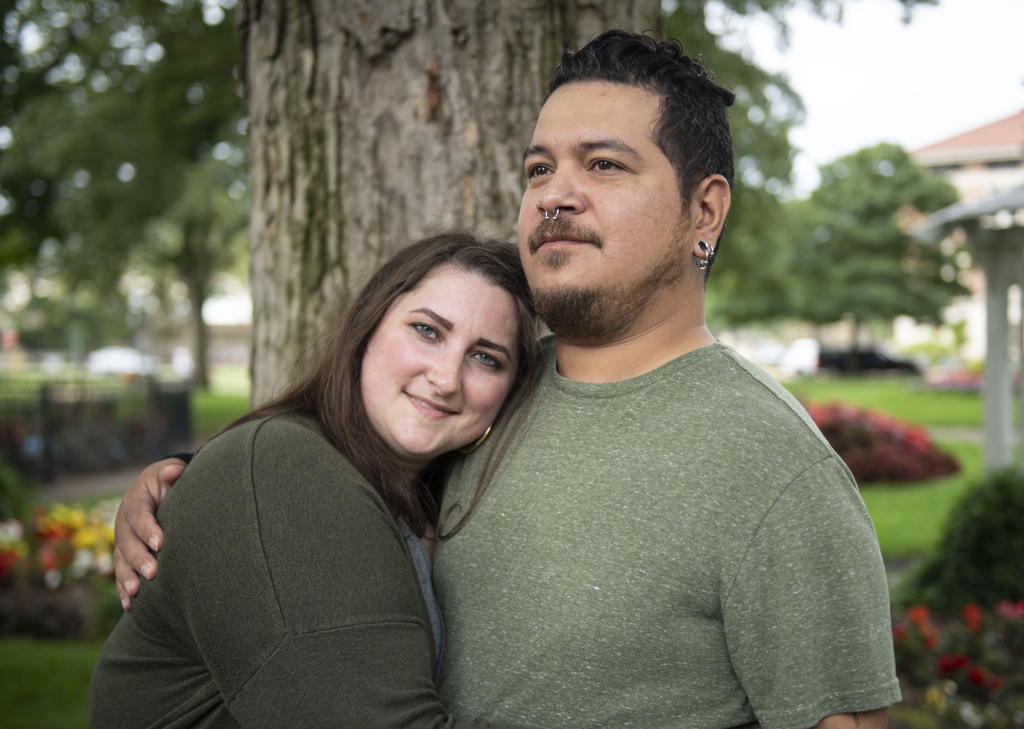On April 25, 2018, when Miguel Munoz first began to show signs of illness, he couldn’t have guessed at the cascade of health problems he’d soon be confronting.
It started with flu-like symptoms and general malaise.
He remembers that day clearly because just a day prior it had been the birthday of his then-fiancée, Amanda Gibson.
He first met Gibson in 2017 at Charter House Innovations in Zeeland, Michigan, where he worked as a machine operator and she as a graphic designer.
Consequently, they were both at work that afternoon when Munoz fell ill.
“His energy was so low,” Gibson said. “I found him one day at work with his eyes closed while others were helping with his work and running his machine.”
Alongside the debilitating back pain, Munoz, 34, struggled with painful constipation.
About six days later, with some convincing from Gibson, Munoz hobbled into an emergency room in west Michigan.
The doctor diagnosed him with high blood pressure and recommended he take Norco for his back pain instead of the ibuprofen he’d been using, as that might be the cause of his constipation.
Munoz returned home but the pain wouldn’t subside.
In fact, as the days passed, it worsened.
“Rapidly worse,” Munoz said.
On May 8, about two weeks after trouble first arose, Munoz went back to the hospital, where doctors ordered an MRI scan of his back.
The situation quickly spiraled from there.
“When they found MRSA in my blood, I was sent to Spectrum Health in Grand Rapids,” Munoz said.
MRSA, or methicillin-resistant staphylococcus aureus, is a serious infection caused by a staph bacteria. It’s often highly resistant to antibiotics.
Worrisome discoveries
The back pain and blood infection weren’t the only assailants on Munoz’ health.
At Spectrum Health, as infectious disease doctors began treating the MRSA, imaging tests of Munoz’ back showed a mass near his kidney and spine.
As nephrologists took a closer look at his kidneys, which showed high levels of creatinine—a sign of renal disease—yet another issue cropped up.
Doctors found an aneurysm developing in Munoz’ aorta.
By mid-May, doctors moved Munoz to the Spectrum Health Fred and Lena Meijer Heart Center, where the focus shifted to monitoring the aneurysm.
Eanas Yassa, MD, section chief of vascular surgery, met her new patient.
“Initially, we described it as an aortic ulcer,” Dr. Yassa said. “It was quickly growing larger, because an infection like MRSA can make it grow fast.
“The wall of his aorta was eroded by infection and, at that point, the body attempts to build a wall around it to contain it,” she said. “Inside that wall, the aneurysm had already ruptured but appeared contained.”
As doctors began to pinpoint and treat his ailments, Munoz braced himself for the rough road ahead.
“It seemed like everything went into high gear at that point,” he said.
Dr. Yassa and Spectrum Health cardiothoracic surgeon Tomasz Timek, MD, met with Munoz and Gibson to discuss the seriousness of his condition. They then quickly met with cardiothoracic anesthesiologists to clear their schedules for the surgery.
The longest day
On May 22, 2018, Munoz underwent his first kidney dialysis treatment.
A day later, Dr. Timek joined Dr. Yassa in the operating room to work on Munoz as a team.
They placed Munoz on complete circulatory arrest during surgery, stopping his blood flow to his organs so they could perform their work.
“His kidneys were already failing at this point, so he was put on dialysis during surgery,” Dr. Yassa said.
The mysterious mass near his kidneys and spine? A pocket of pus from infection.
“His spleen was engorged from the infection and burst when touched, so we removed it,” Dr. Timek said. “We used leg vein to bypass the blood flow to the liver, pancreas, stomach and intestines.”
Dr. Yassa worked on the aneurysm. Typically she would use a mesh tube to repair it, but in this case she used two pieces of aorta from a donor cadaver.
“Because of the extent of the infection, we had a high level of certainty that any graft material would get infected and then destroy more of the healthy aorta,” the doctor explained, then added: “People tend to think of kidneys, hearts and big organs as being important for organ donation, but Miguel’s surgery would not have been possible without organ donation of blood vessels. All kinds of organ donations are important.”
The surgery took nearly 13 hours.
“I learned later that the surgeons saw the infection was even worse than expected when I was in surgery,” Munoz said. “They thought I would be in the hospital for as long as three months.”
He spent about a week and a half in the intensive care unit.
The fight is on
Munoz’ recovery went fast—faster than anyone expected.
Still, his vitals caused his doctors some concern. His systolic blood pressure, the top reading, hit 202, which is considered hypertensive crisis.
“It was scary high,” Munoz said.
“But not that scary,” Gibson said. “We trusted the people taking care of us.”
But his recovery didn’t take three months. It didn’t even take two months.
His blood pressure soon returned to normal and, within about two weeks, he got the green light.
“I went home on June 6,” Munoz said, smiling. “Yeah, recovery was crazy fast. I think they were impressed.”
Dr. Timek agreed.
“It was indeed fast,” the doctor said. “Age was on his side. We don’t usually see infections like this in someone as young as Miguel. And that helped him.”
Munoz now undergoes kidney dialysis three times a week.
He’s on a waiting list for a kidney transplant. He remains hopeful he’ll receive one within the next four years.
Hope, after all, got him and his family through this ordeal.
“I couldn’t have gotten through all this without Amanda by my side,” Munoz said.
Their experience last year only strengthened their bond.
“When I first saw Amanda at the office at work, I thought she was too nice to approach,” Munoz said. Once he mustered up the courage and asked her out, they hit it off.
On Dec. 31, 2018, under a gazebo in Holland, Michigan, Munoz and Gibson married.
It’s said that rain on a wedding brings good luck.
Gibson—now going by Amanda Munoz—remembers that special day as lucky indeed.
“There wasn’t snow,” Gibson said. “It rained. It poured.”










 /a>
/a>
 /a>
/a>
 /a>
/a>
Dear Miguel, When I started to read your story I could not put the article down. Your story will be an inspiration to all who read it.
God most certainly has a plan for your life!
Blessings to you and Amanda for a wonderful life.
Marilyn
I am inspired by this story i am so happy that time and God was on his side may god keep blessing you and your family..